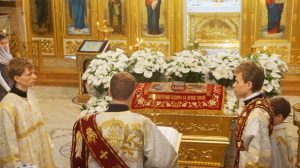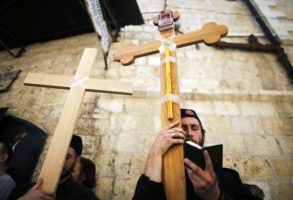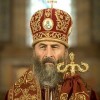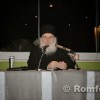Source: www.antiochian.org
Great Lent and Holy Week are two separate fasts, and two separate celebrations. Great Lent ends on Friday of the fifth week (the day before Lazarus Saturday). Holy Week begins immediately thereafter.
Lazarus Saturday: Lazarus Saturday is the beginning of Holy Week. It commemorates the raising of Lazarus, our Lord’s friend, who was in the tomb 4 days. This act confirms the universal resurrection from the dead that all of us will experience at our Lord’s Second Coming. This miracle led many to faith, but it also led to the chief priest’s and Pharisees’ decision to kill Jesus (John 11:47-57).
Palm Sunday (The Enterance of our Lord into Jerusalem): Our Lord enters Jerusalem and is proclaimed king – but in an earthly sense, as many people of His time were seeking a political Messiah. Our Lord is a king, of course, but of a different type – the King prophesied by Zechariah the Prophet. We use palms on this day to show that we too accept Jesus as the true King and Messiah of the Jews, Who we are willing to follow – even to the cross.
Holy Monday, Tuesday and Wednesday: The first thing that must be said about these services, and most of the other services of Holy Week, is that these services are “sung” in anticipation. Each service is rotated ahead 12 hours. The evening service, therefore, is actually the service of the next morning, while the morning services of Holy Thursday and Holy Saturday are actually the services of the coming evening.
Understanding that, let’s turn to the Services of Holy Monday, Tuesday and Wednesday (celebrated Palm Sunday , Monday and Tuesday evening). The services of these days are known as the Bridegroom or Nymphios Orthros Services. At the first service of Palm Sunday evening, the priest carries the icon of Christ the Bridegroom in procession, and we sings the “hymn of the bridegroom.” We behold Christ as the Bridegroom of the Church, bearing the marks of His suffering, yet preparing a marriage Feast for us in God’s Kingdom.
Each of these Bridegroom Orthros services has a particular theme. On Holy Monday, the Blessed Joseph, the son of Jacob the Patriarch, is commemorated. Joseph is often seen as a Type of Christ. Joseph was betrayed by his brothers, thrown into a pit and sold into slavery by them. In the same way, our Lord was rejected, betrayed by His own, and sold into the slavery of death. The Gospel reading for the day is The Barren Fig Tree, which Christ cursed and withered because it bore no fruit. The fig tree is a parable of those who have heard God’s word, but who fail to bear the fruit of obedience. Originally the withering of the fig tree was a testimony against those Jews who rejected God’s word and His Messiah. However, it is also a warning to all people, in all times, of the importance of not only hearing the God’s word, but putting it into action. The Parable of the Ten Virgins is read on Holy Tuesday. It tells the story of the five virgins who filled their lamps in preparation for receiving the bridegroom while the other five allowed their lamps to go out and hence were shut out of the marriage feast. This parable is a warning that we must always be prepared to receive our Lord when He comes again. The theme of the day is reinforced by the expostelarion hymn we sing: “I see Thy Bridal Chamber adorned, O my Savior, but have no wedding garment that I may enter. O Giver of Light, enlighten the vesture of my soul, and save me.” The theme of Holy Wednesday is repentance and forgiveness. We remember the sinful woman, Kassiane, who anointed our Lord in anticipation of His death. Her repentance and love of Christ is the theme of the wonderful “Hymn of Kassiane” which is chanted on this night, reminding us one more time, before “it is too late,” that we too may be forgiven if we repent.
Holy Unction: The Mystery or Sacrament of Holy Unction is celebrated on Holy Wednesday evening. This is not historically part of Holy Week. Actually this service can be celebrated any time during the year, especially when one is ill. However, because of our need for forgiveness and spiritual healing, we offer this service during Holy Week for the remission of our sins. We should prepare for this service in a prayerful way, as we do for Holy Communion.
Great and Holy Thursday: On Holy Thursday twe turn to the last events of our Lord and His Passion. Thursday morning begins with a Vesperal Divine Liturgy commemorating the Mystical Supper (remember, this is actually Holy Thursday evening’s service celebrated in the morning in anticipation). Everyone who is able should make an effort to receive Holy Communion at this service as it was at the Mystical Supper that our Lord instituted the Holy Eucharist. At this Liturgy a second Host is consecrated and kept in the Tabernacle. It is from this Host that Holy Communion is distributed to the shut-ins and the sick throughout the coming year.
Thursday evening actually begins the services of Great and Holy Friday. The service of the 12 Passion Gospels commemorates the solmn time of our Lord’s Crucifixion. After the reading of the 5th Gospel, the holy cross is carried around the church in procession, and Christ’s body is nailed to the cross in the center of the church.
Great and Holy Friday: This is a day of strict fast. As little as possible – preferably nothing – should be eaten on this day. It is the only day in the entire year that no Divine Liturgy of any kind can be celebrated. In the morning we celebrate the Royal Hours. These solemn hours are observed as we read the various accounts and hymns concerning the crucifixion. In the afternoon we celebrate the Vesper service of the taking down of Christ’s body from the cross. During the Gospel reading, our Lord’s body is taken off the cross and wrapped in a new, white linen sheet. This act commemorates the removal of Christ’s body from the cross by Joseph of Arimathea (John 19:38-42). Later in the service, the Epitaphios, or winding-sheet, with Christ’s body on it is carried in procession and placed in the recently decorated tomb. In the evening the Lamentations Orthros service is sung. This service begins in a solemn manner, but by the end of the service we are already anticipating the Resurrection of our Lord. Keep in mind, that the Holy Friday evening Orthros is actually the first service of Holy Saturday, the day in which we commemorate our Lord’s body resting in the tomb while His all-pure soul descends into hades to free the faithful of the Old Covenant.
Great and Holy Saturday: This day is a day of hope and waiting. In the morning we celebrate a Vesperal Divine Liturgy which commemorates Christ’s victory over death. Bright vestments are worn as we anticipate Christ’s Resurrection. Laurel leqaves are strewn throughout the church during the service, because in the ancient world laurel leaves were a sign of victory. As the leaves are strewn, the choir chants “Arise O God and Judge the earth, for to Thee belong all the nations.” The Old Testament story of Jonah in the belly of the whale is read at this service because Jonah is seen in the Church as a Type of Christ. As Jonah was three days in the belly of the great fish, and was then safely deposited back onto land, so our Lord was three days in the tomb before His glorious Resurrection. The Vesperal Divine Liturgy of Holy Saturday concludes the services of Holy Week, and brings us to the eve of Great and Holy Pascha.



















